Rock Classification Using Multivariate Analysis of Measurement While Drilling Data: Towards a Better Sampling Strategy
Abstract
:1. Introduction
2. Background
3. Materials and Methods
3.1. Data
3.2. Pre-Processing MWD Data
3.3. Hidden Markov Models
- Most likely sequence of rock classes given all MWD data: .
- Estimation of model parameters , , for , and .
3.4. Rock Class Prediction
3.5. Parameter Estimation—EM Algorithm
3.6. Workflow Summary
| Algorithm 1 Workflow. |
|
4. Results
4.1. Identifying the Best HMM for Rock Classification
- Even though fluctuations due to rod change are eliminated in the pre-processing, feed pressure and percussion pressure are showing trends in approximately every 3.5 m depth (see Figure 8). This variation is also visible in dampening pressure with less intensity. In Figure 9, one can see that MAPall, MAPno Flushair and MAPPD are showing trends in approximately every 3.5 m depth. Because of this possible mis-classification we are not considering MAPall, MAPno Flushair and MAPPD for further analysis.
- The penetration rate depends on the pressures and the rock characteristics. In theory, a model with more variables will give better results. So MAPP is also not considering further.
4.2. Precision and Characteristics of Predicted Classes
5. Discussion
6. Conclusions
Supplementary Materials
Author Contributions
Funding
Acknowledgments
Conflicts of Interest
Abbreviations
| MWD | Measurement while drilling |
| HMM | Hidden Markov Models |
| MSUS | Magnetic Susceptibility |
| SGAM | Spectral gamma |
Appendix A. Forward-Backward Algorithm
Appendix B. Parameter Updates in EM Algorithm
References
- Lamberg, P.; Rosenkranz, J.; Wanhainen, C.; Lund, C.; Minz, F.; Mwanga, A.; Parian, M. Building a geometallurgical model in iron ores using a mineralogical approach with liberation data. In Proceedings of the The Second AUSIMM International Geometallurgy Conference, Brisbane, Australia, 26 November 2013; Volume 30, pp. 317–324. [Google Scholar]
- Bunkholt, I. Beneficiation of Carbonates—Interactions Between Raw Material Properties and Processing Performance to High-Grade Fluid Filler and Coating for the Paper Industry. In Minerals Engineering; Luleå Technical University: Luleå, Sweden, 2011. [Google Scholar]
- Watne, T. Geological Variation in Marble Deposits: Implication for the Mining of Raw Material for Ground Calcium Carbonate Slurry Products. Ph.D. Thesis, NTNU Trondheim, Trondheim, Norway, 2001. [Google Scholar]
- Marinos, P.; Hoek, E. Estimating the geotechnical properties of heterogeneous rock masses such as flysch. Bull. Eng. Geol. Environ. 2001, 60, 85–92. [Google Scholar] [CrossRef]
- Xie, H.; Pei, J.; Zuo, J.; Zhang, R. Investigation of mechanical properties of fractured marbles by uniaxial compression tests. J. Rock Mech. Geotech. Eng. 2011, 3, 302–313. [Google Scholar] [CrossRef]
- Vezhapparambu, V.S. Increased geometallurgical performance in industrial mineral operations through multivariate analysis of MWD-data. Tech. Note Mineralproduksjon 2016, 7, B25–B32. [Google Scholar]
- Rai, P.; Schunesson, H.; Lindqvist, P.A.; Kumar, U. An Overview on Measurement-While-Drilling Technique and its Scope in Excavation Industry. J. Inst. Eng. Ser. D 2015, 96, 57–66. [Google Scholar] [CrossRef]
- Ghosh, R.; Schunnesson, H.; Kumar, U. The use of specific energy in rotary drilling: The effect of operational parameters. In Proceedings of the International Symposium on the Application of Computers and Operations Research in the Mineral Industry, Fairbanks, AK, USA, 23–27 May 2015. [Google Scholar]
- Segui, J.; Higgins, M. Blast design using measurement while drilling parameters. Fragblast 2002, 6, 287–299. [Google Scholar] [CrossRef]
- Vezhapparambu, V.S.; Ellefmo, S.L. Change point analysis of MWD-data to detect the broken ground thickness in open pit mining. In Proceedings of the International Association for Mathematical Geosciences (IAMG), Perth, Australia, 2–9 September 2017. [Google Scholar]
- Schunesson, H. RQD Predictions based on drill performance parameters. Tunn. Undergr. Space Technol. 1996, 11, 345–351. [Google Scholar] [CrossRef]
- Peck, J.P. Performance Monitoring of Rotary Blasthole Drills. Ph.D. Thesis, McGill University, Montreal, QC, Canada, 1989. [Google Scholar]
- Schunesson, H. Rock characterisation using percussive drilling. Int. J. Rock Mech. Min. Sci. 1998, 35, 711–725. [Google Scholar] [CrossRef]
- Hunt, C.P.; Moskowitz, B.M.; Banerjee, S.K. Magnetic Properties of Rocks and Minerals. In Rock Physics and Phase Relations; American Geophysical Union: Washington, DC, USA, 1995; pp. 189–204. [Google Scholar]
- Killick, R.; Eckley, I. Changepoint: An R package for changepoint analysis. J. Stat. Softw. 2014, 58, 1–19. [Google Scholar] [CrossRef]
- Moritz, S.; Bartz-Beielstein, T. imputeTS: Time Series Missing Value Imputation in R. R J. 2017, 9, 207–218. [Google Scholar]
- Zucchini, W.; MacDonald, I.L.; Langrock, R. Hidden Markov Models for Time Series: An Introduction Using R; CRC Press: Boca Raton, FL, USA, 2016; Volume 150. [Google Scholar]
- Eidsvik, J.; Mukerji, T.; Switzer, P. Estimation of geological attributes from a well log: An application of hidden markov chains. Math. Geol. 2004, 36, 379–397. [Google Scholar] [CrossRef]
- Lindberg, D.V.; Rimstad, E.; Omre, H. Inversion of well logs into facies accounting for spatial dependencies and convolution effects. J. Petrol. Sci. Eng. 2015, 134, 237–246. [Google Scholar] [CrossRef]
- Fjeldstad, T.; Grana, D. Joint probabilistic petrophysics-seismic inversion based on Gaussian mixture and Markov chain prior models. Geophysics 2017, 83, 1–46. [Google Scholar] [CrossRef]
- Kadkhodaie-Ilkhchi, A.; Monteiro, S.T.; Ramos, F.; Hatherly, P. Rock recognition from MWD data: A comparative study of boosting, neural networks, and fuzzy logic. IEEE Geosci. Remote Sens. Lett. 2010, 7, 680–684. [Google Scholar] [CrossRef]
- Su, O. Performance evaluation of button bits in coal measure rocks by using multiple regression analyses. Rock Mech. Rock Eng. 2016, 49, 541–553. [Google Scholar] [CrossRef]
- Scott, S.L. Bayesian methods for hidden Markov models: Recursive computing in the 21st century. J. Am. Stat. Assoc. 2002, 97, 337–351. [Google Scholar] [CrossRef]
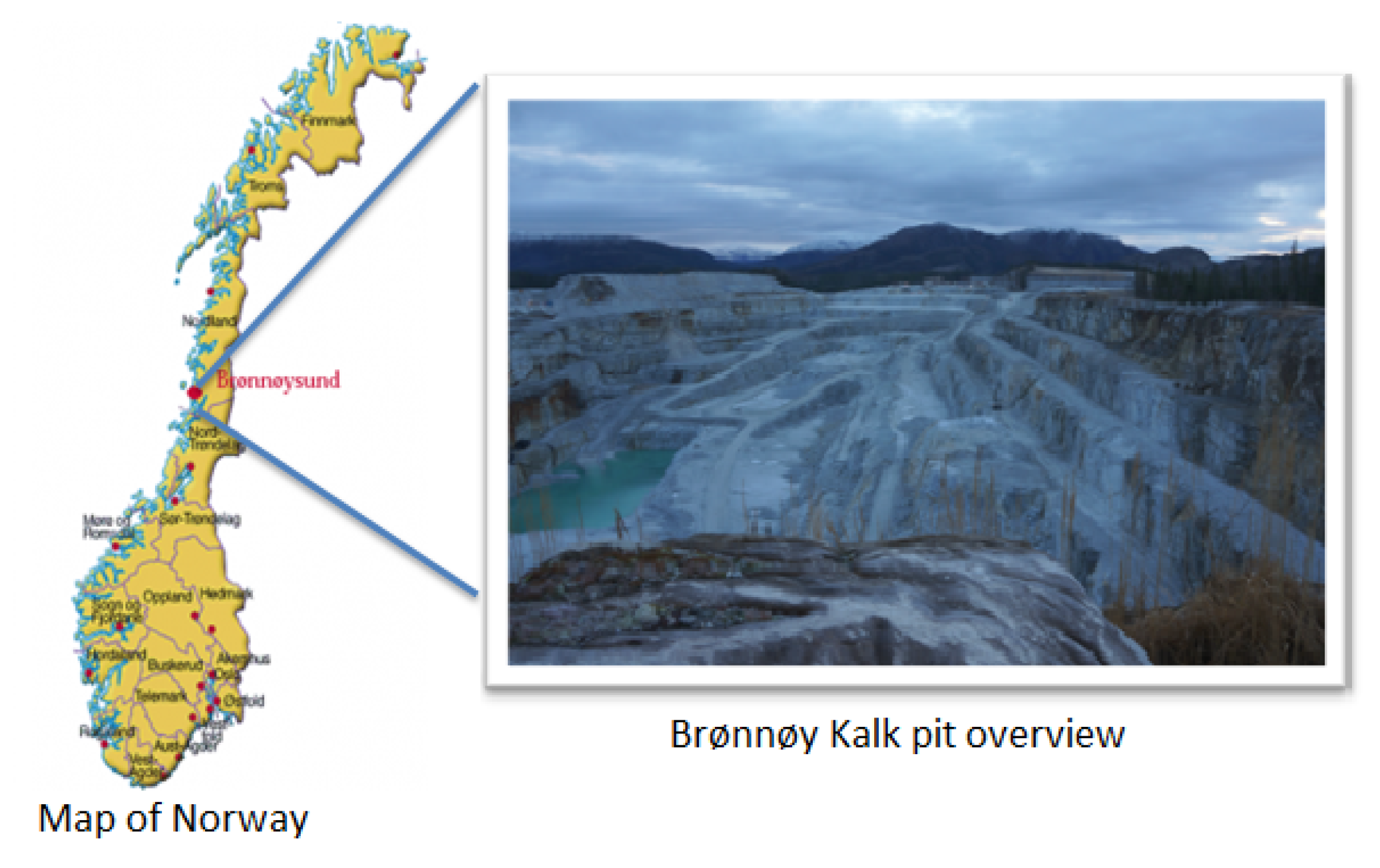
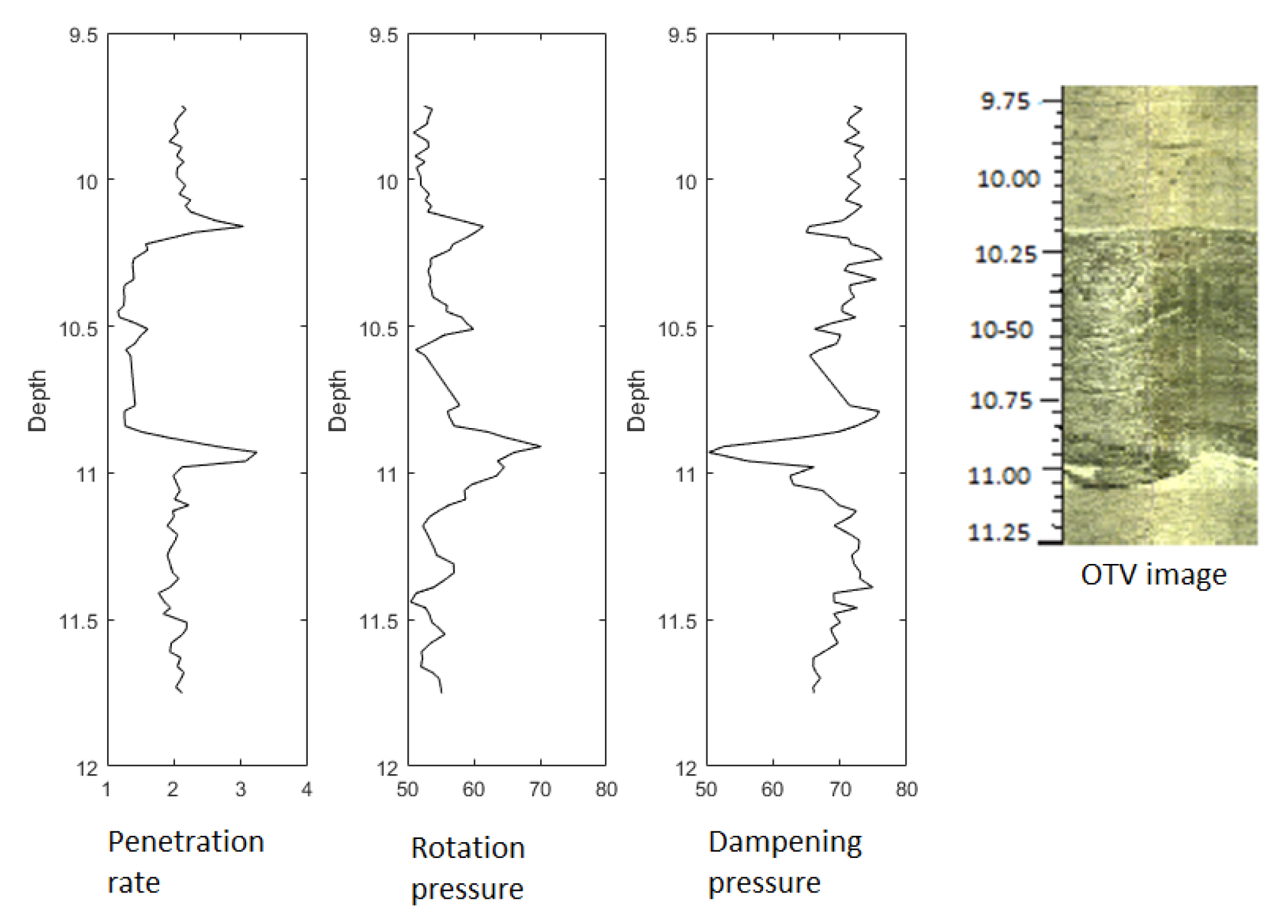
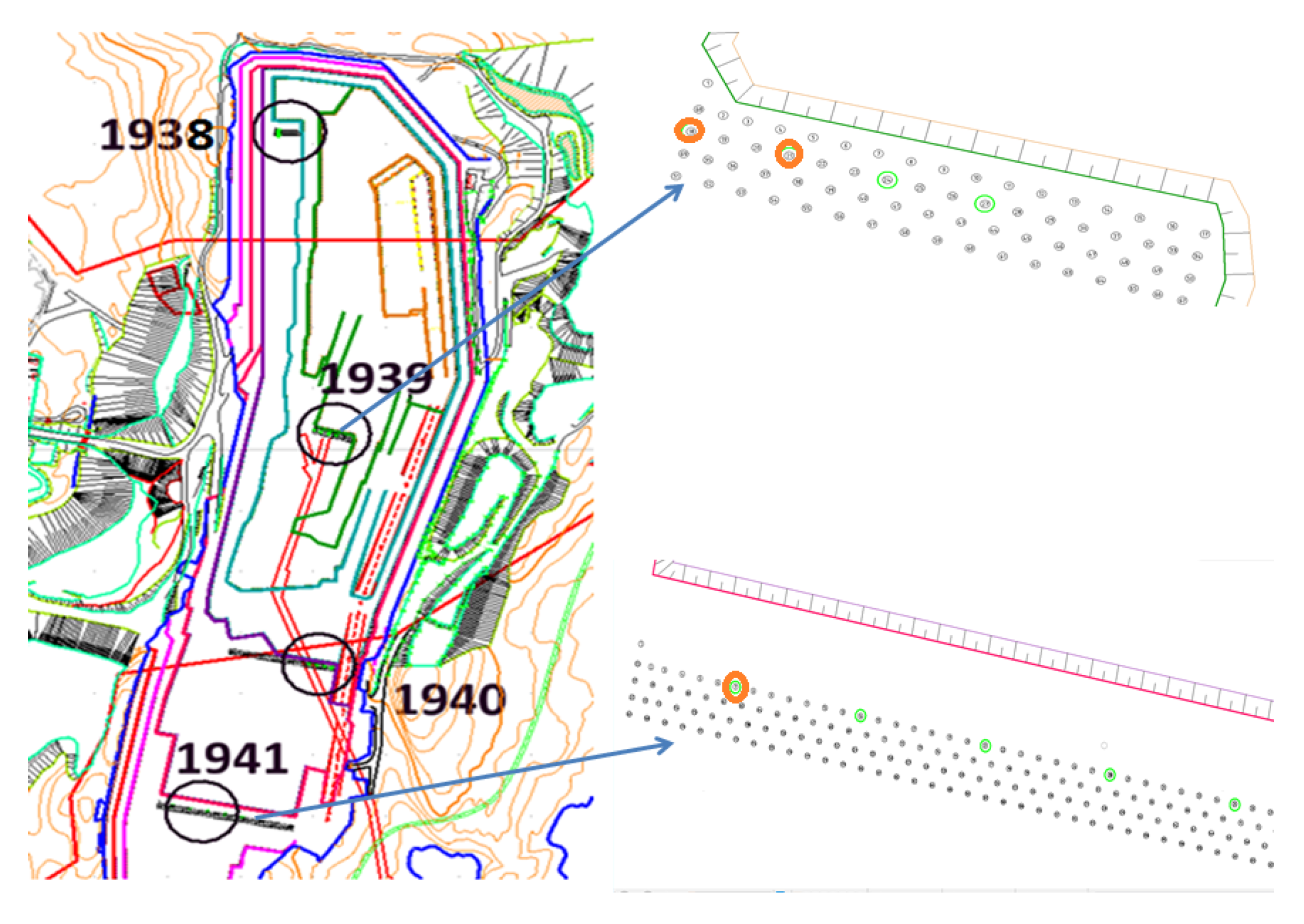
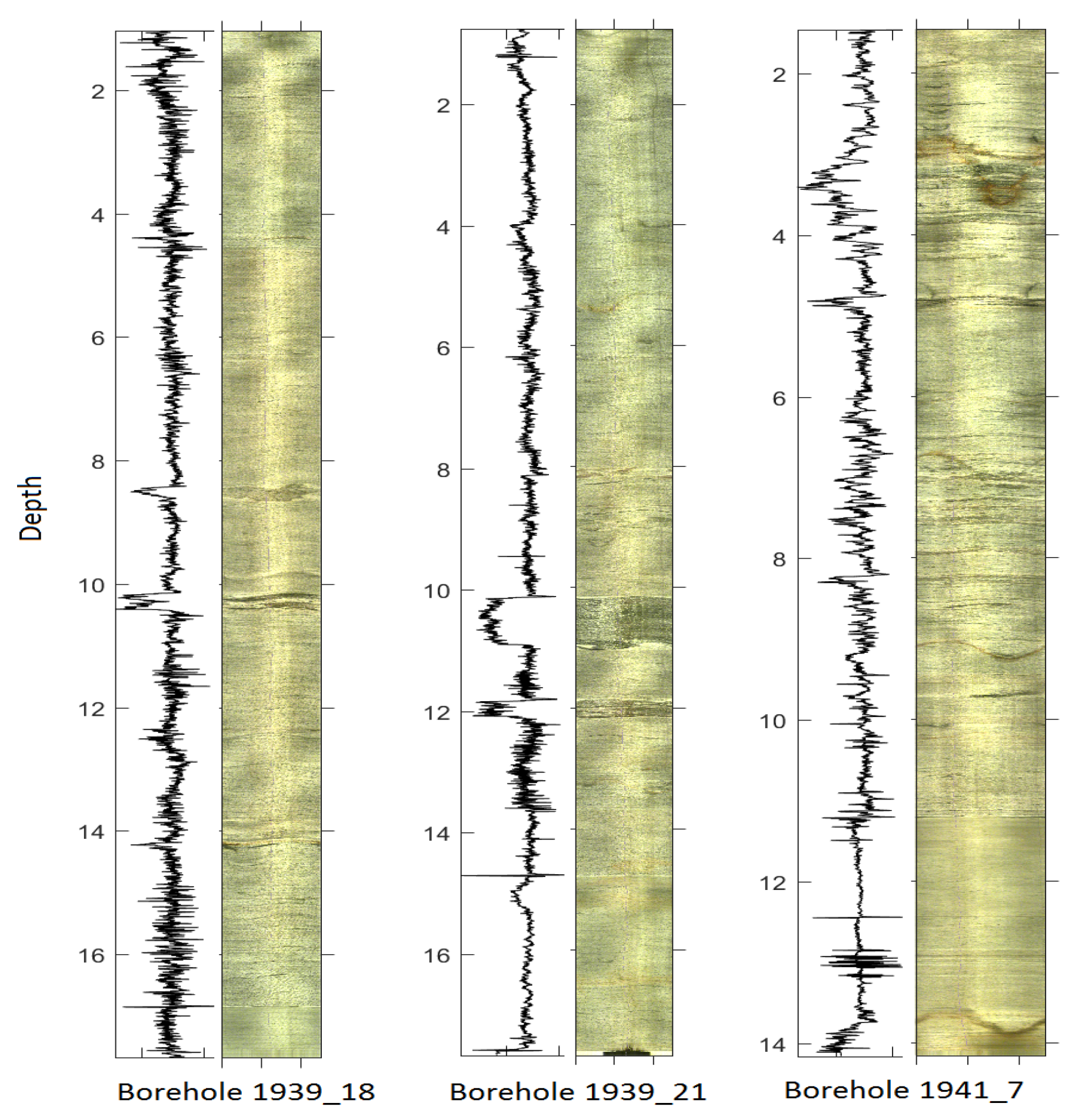
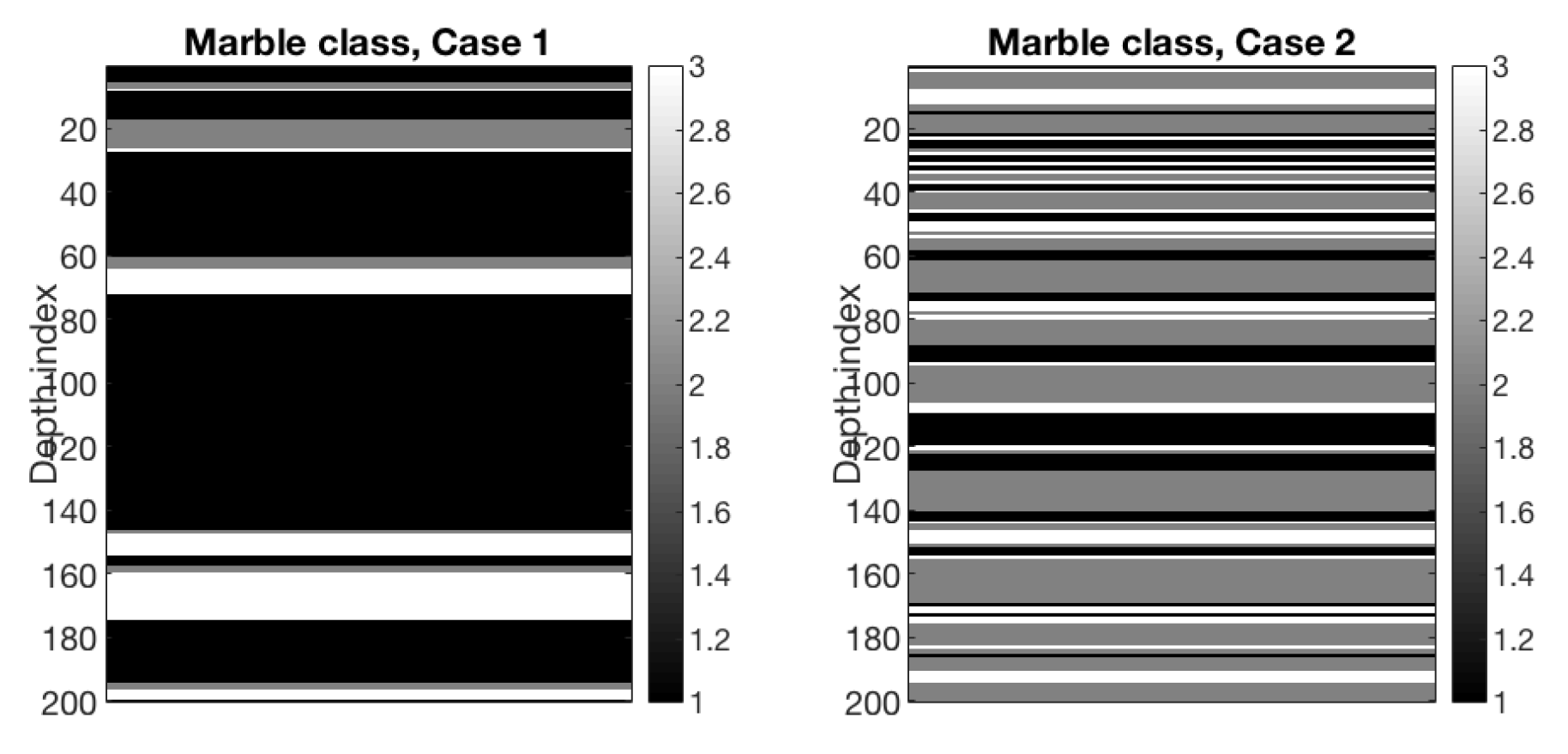

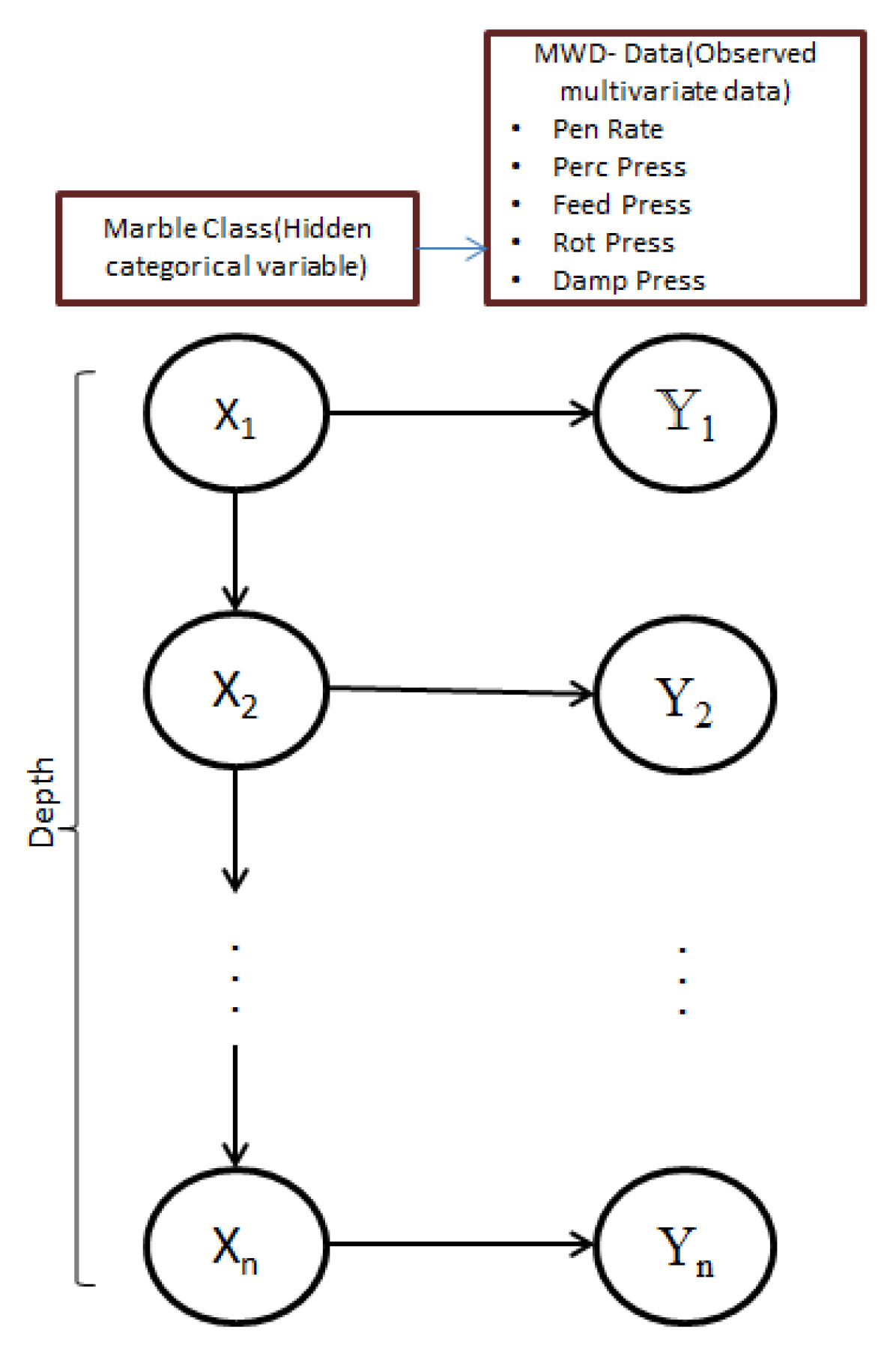
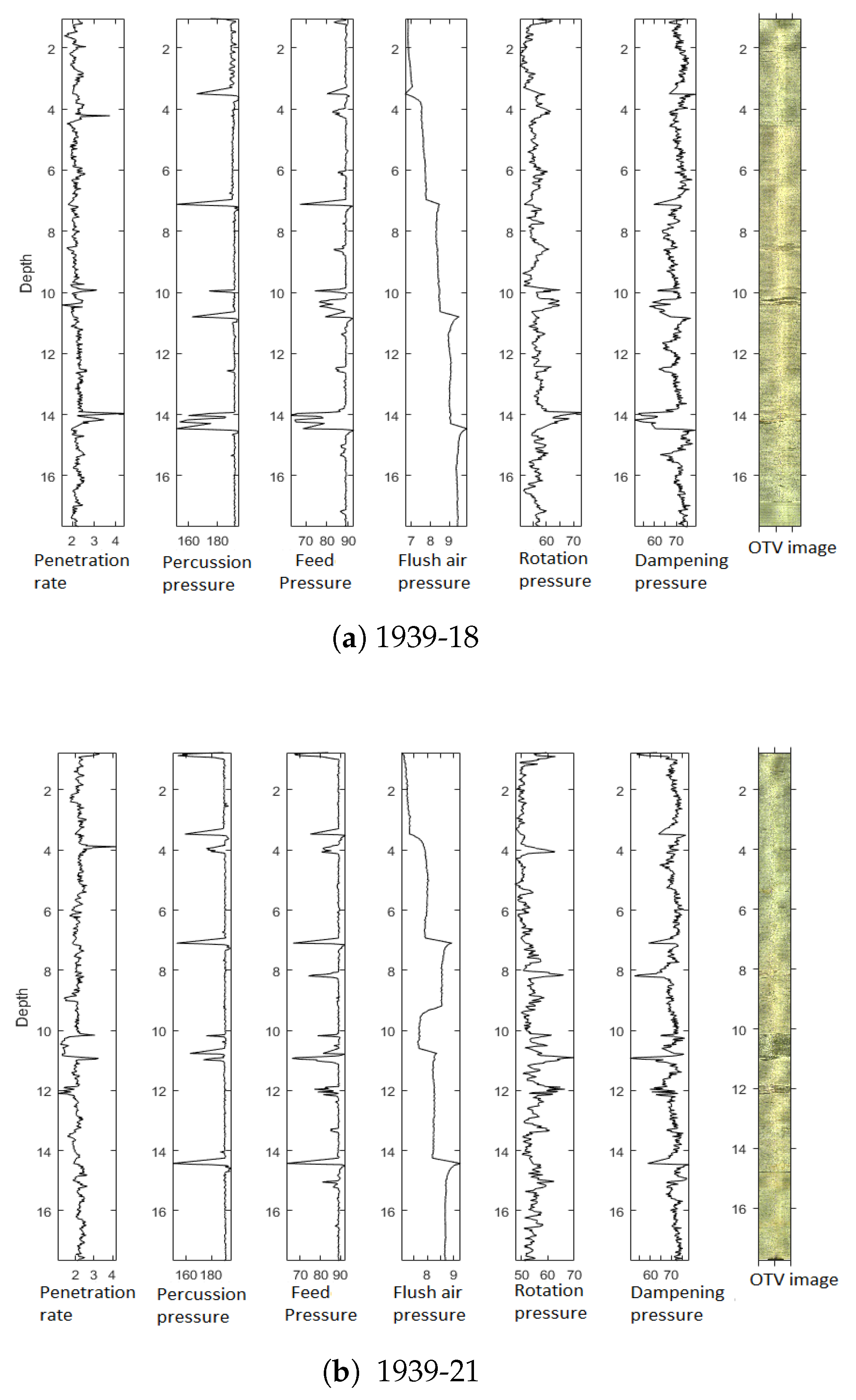
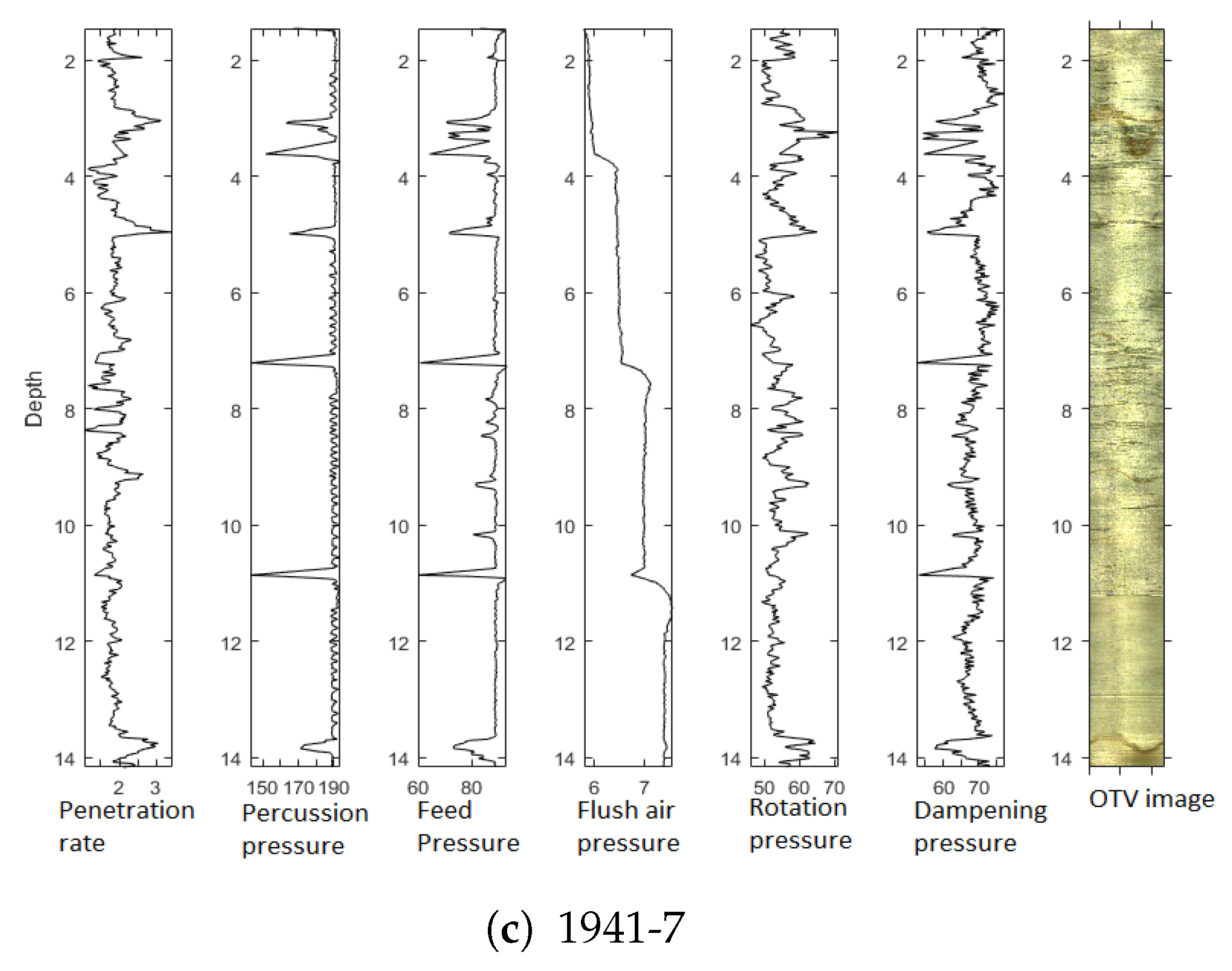

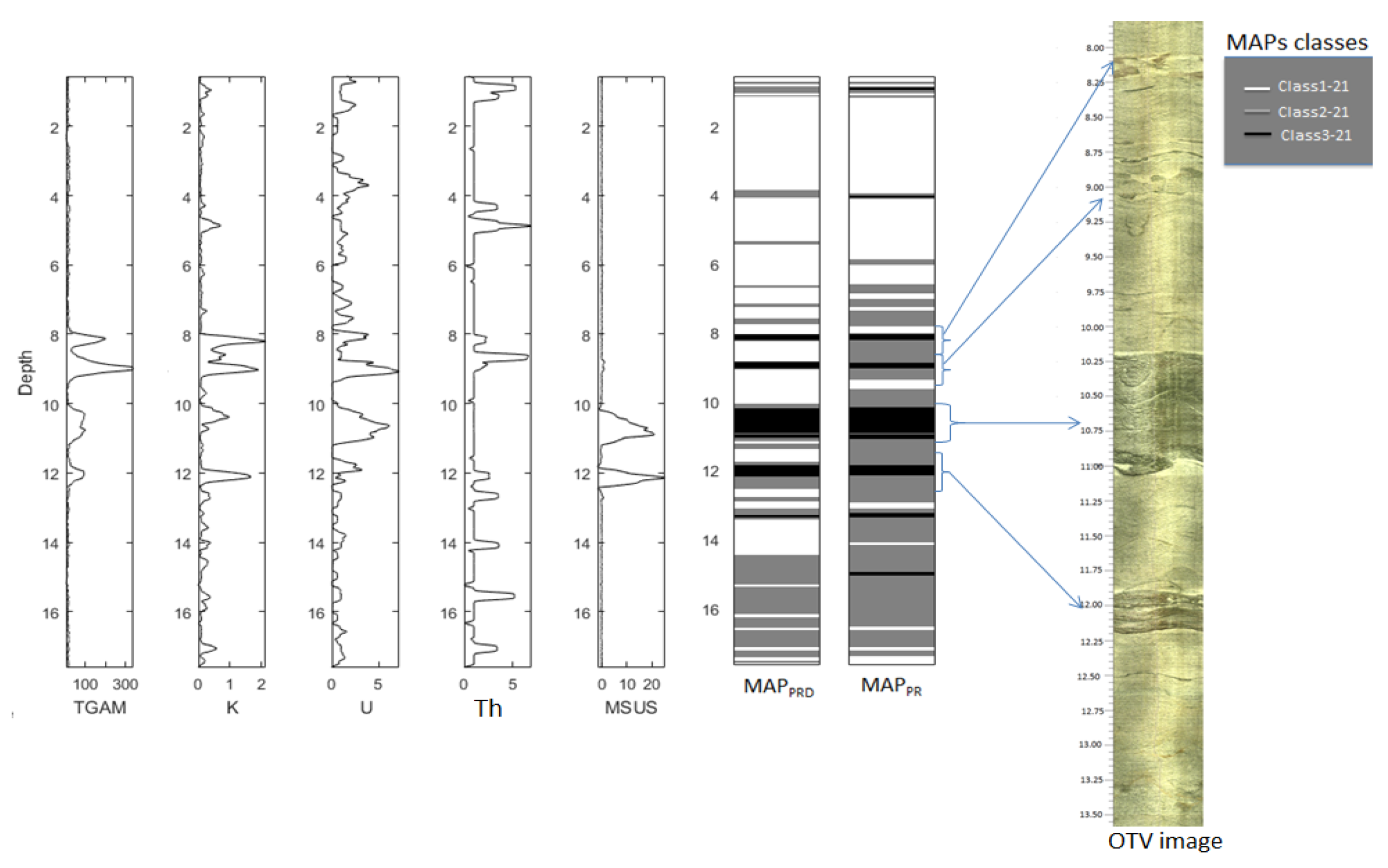
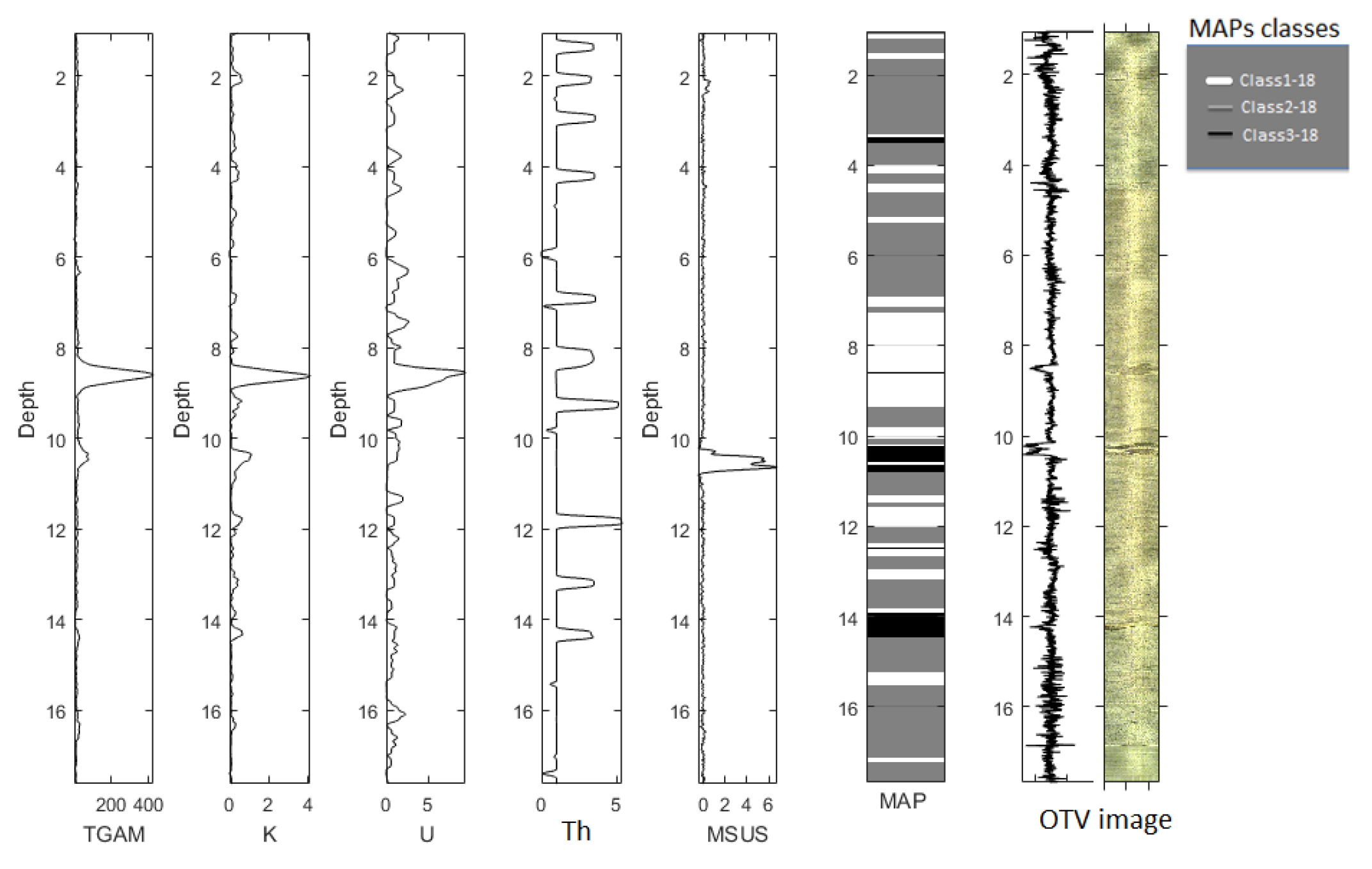
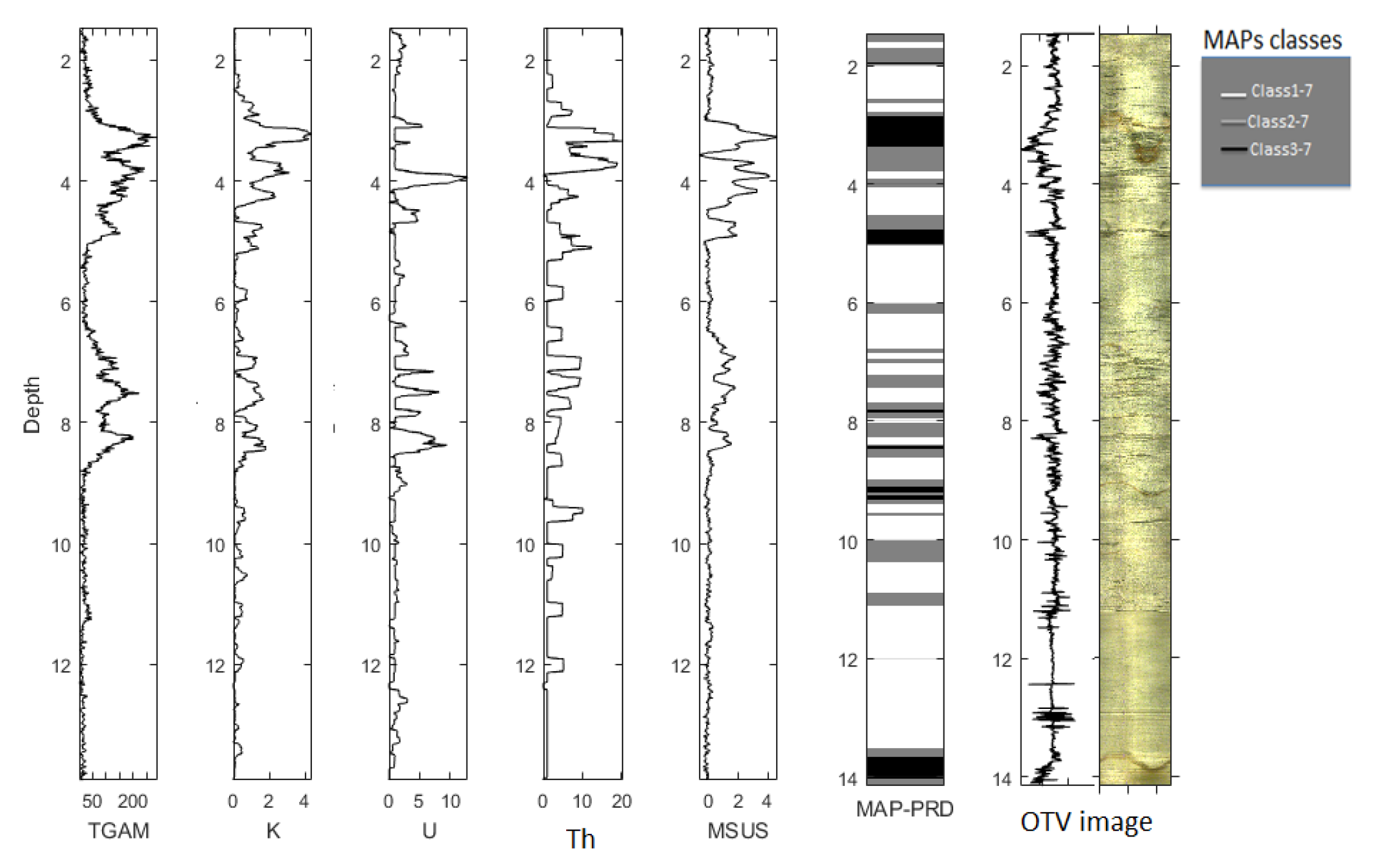
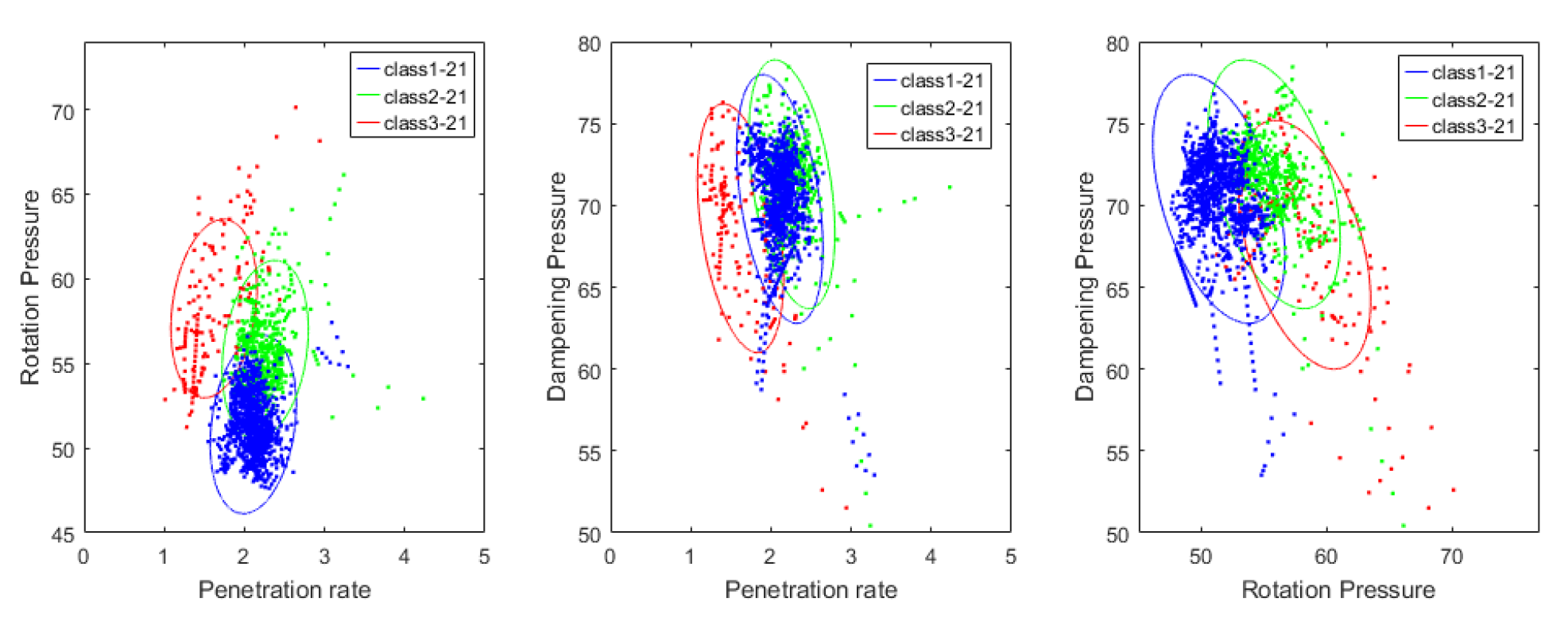
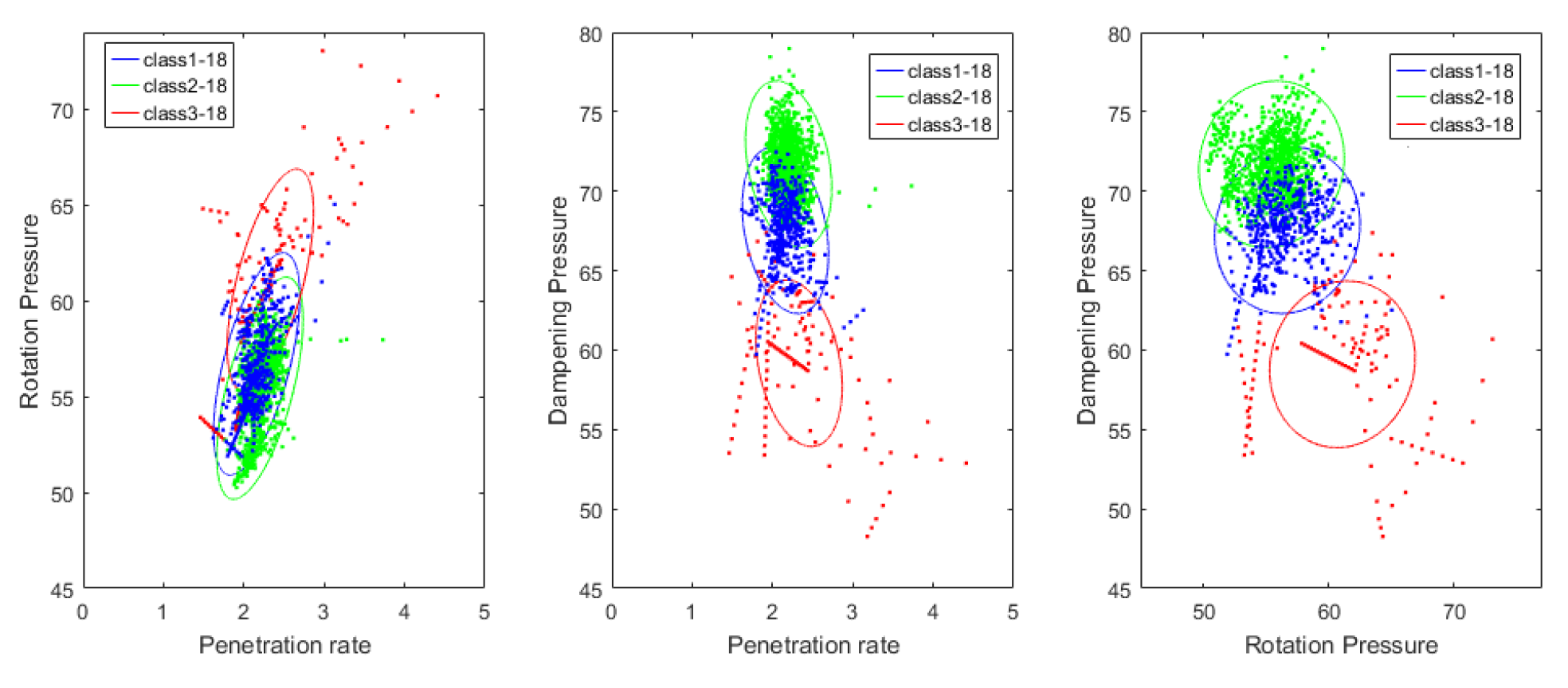
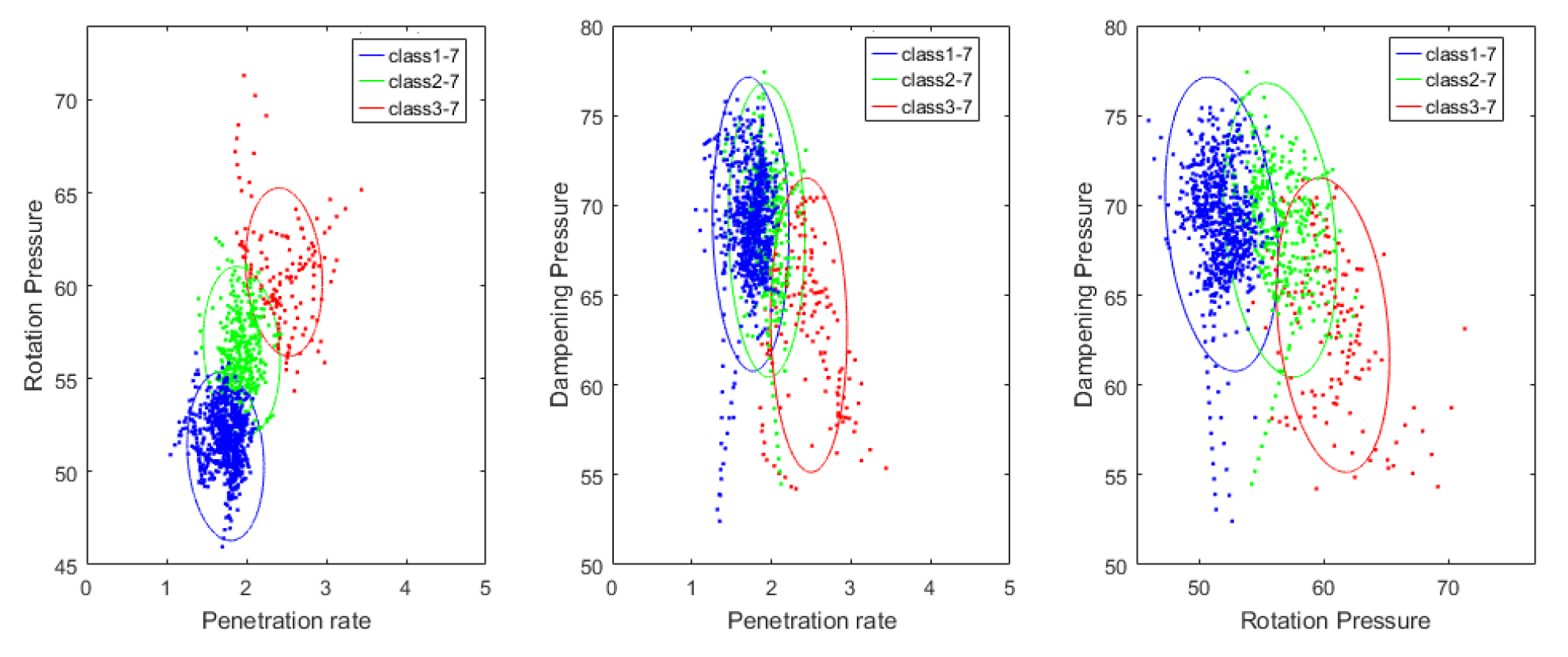
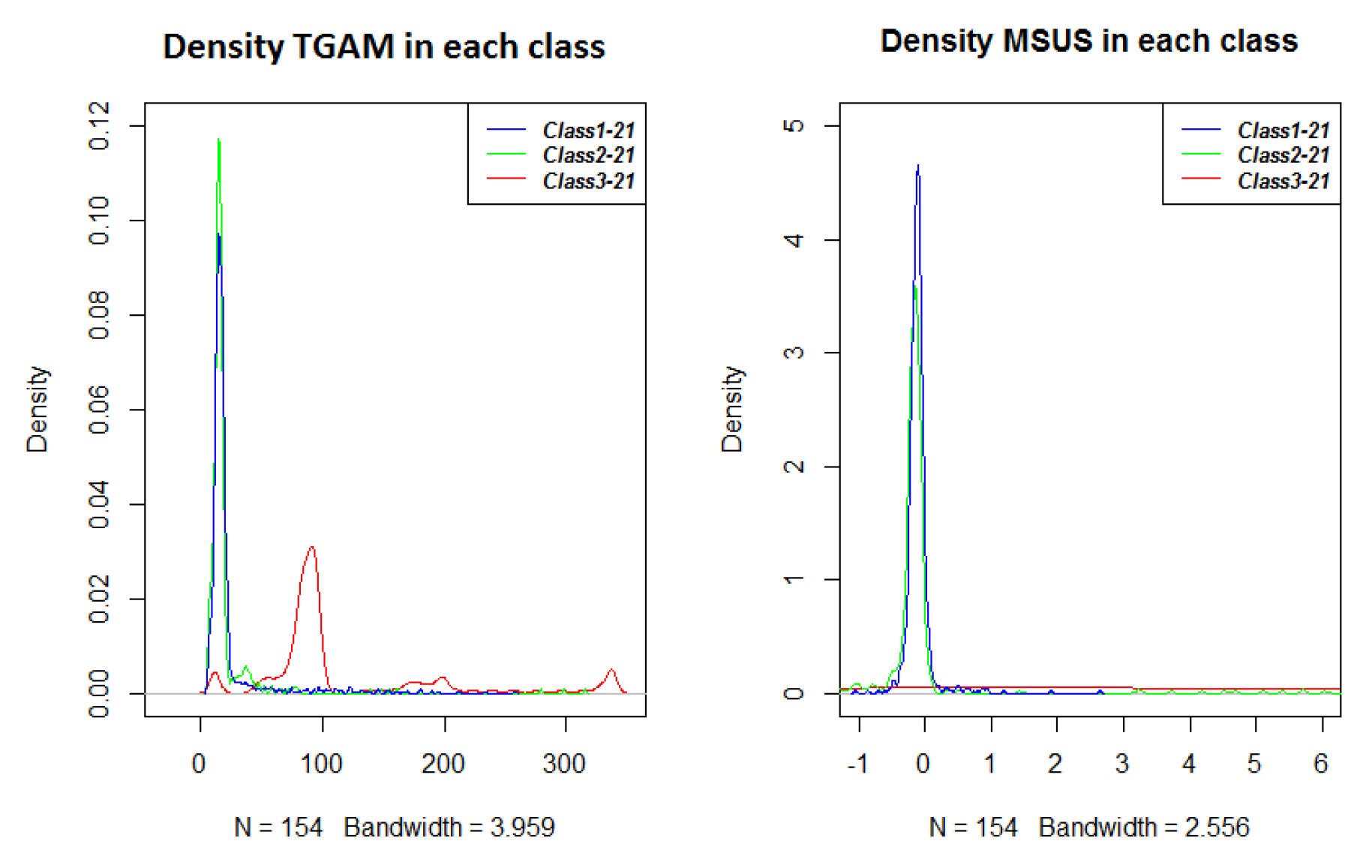


| MWD | 1939-18 | 1939-21 | 1941-7 |
|---|---|---|---|
| Penetration rate (m/s) | 2.20(0.22) | 2.11(0.28) | 1.88(0.31) |
| Percussion pressure (Bar) | 189.67(5.97) | 189.35(5.50) | 188.39(6.56) |
| feed pressure (Bar) | 87.69(3.95) | 87.95(3.51) | 87.34(4.55) |
| Flush air pressure (Bar) | 8.36(0.90) | 8.12(0.50) | 6.77(0.52) |
| Rotation pressure (Bar) | 56.28(2.83) | 53.36(3.35) | 54.17(3.65) |
| Dampening pressure (Bar) | 69.68(3.81) | 70.44(3.32) | 68.22(3.83) |
| Class | Pen Rate | Rot Press | Damp Ress | MSUS | TGAM | Assigned Class |
|---|---|---|---|---|---|---|
| Class1-18 | 2.2 | 57.7 | 67.5 | −0.1 | 16.6 | Pure Marble |
| Class2-18 | 2.2 | 55.4 | 71.7 | 0 | 40.7 | Pure Marble |
| Class3-18 | 2.3 | 61.8 | 59.2 | 1.2 | 46.7 | Fracture/small intrusion |
| Class1-21 | 2.1 | 51.4 | 70.4 | −0.1 | 22.2 | Pure Marble |
| Class2-21 | 2.3 | 55.8 | 71.3 | 0.5 | 20.1 | Pure Marble |
| Class3-21 | 1.6 | 58.2 | 67.6 | 8.9 | 116.5 | Hard Intrusion |
| Class1-7 | 1.7 | 51.8 | 69.0 | 0.3 | 43.5 | Pure Marble |
| Class2-7 | 1.9 | 56.5 | 68.6 | 0.5 | 71.5 | Impure Marble |
| Class3-7 | 2.5 | 60.7 | 63.3 | 0.9 | 90.8 | Fracture |
© 2018 by the authors. Licensee MDPI, Basel, Switzerland. This article is an open access article distributed under the terms and conditions of the Creative Commons Attribution (CC BY) license (http://creativecommons.org/licenses/by/4.0/).
Share and Cite
Vezhapparambu, V.S.; Eidsvik, J.; Ellefmo, S.L. Rock Classification Using Multivariate Analysis of Measurement While Drilling Data: Towards a Better Sampling Strategy. Minerals 2018, 8, 384. https://doi.org/10.3390/min8090384
Vezhapparambu VS, Eidsvik J, Ellefmo SL. Rock Classification Using Multivariate Analysis of Measurement While Drilling Data: Towards a Better Sampling Strategy. Minerals. 2018; 8(9):384. https://doi.org/10.3390/min8090384
Chicago/Turabian StyleVezhapparambu, Veena S., Jo Eidsvik, and Steinar L. Ellefmo. 2018. "Rock Classification Using Multivariate Analysis of Measurement While Drilling Data: Towards a Better Sampling Strategy" Minerals 8, no. 9: 384. https://doi.org/10.3390/min8090384




